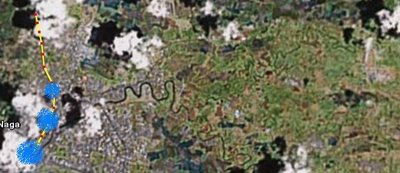Guarded optimism after the ISA event
 FRANK Mendoza, Dave Bercasio and I did a post-event assessment after yesterday's formal launch of the "Mahal Ko ang Pilipinas" (MKAP) movement at the Philippine Plaza Hotel, where more aspiring "Dream Cities" were initiated and eight, including Naga, were declared Public Governance System (PGS)-compliant. Their inputs helped me crystallize some key thoughts after reflecting throughout another bone-jarring roadtrip back home.
FRANK Mendoza, Dave Bercasio and I did a post-event assessment after yesterday's formal launch of the "Mahal Ko ang Pilipinas" (MKAP) movement at the Philippine Plaza Hotel, where more aspiring "Dream Cities" were initiated and eight, including Naga, were declared Public Governance System (PGS)-compliant. Their inputs helped me crystallize some key thoughts after reflecting throughout another bone-jarring roadtrip back home.
Dr. Jesus Estanislao, chair of the Institute for Solidarity in Asia (ISA) which is the prime mover behind the PGS, touched a sympathetic chord in me who has practically given up on the national government. His quietly moving keynote cogently articulated the plaintive cry of a motherland who feels abandoned by her children, thousands of whom are voting with their feet with every passing day. The choice of Gat Andres Bonifacio as a historical inspiration for the movement is therefore most fitting, as his paean to love of country remains very timely and relevant. In a way, I think the MKAP is an indictment of the Arroyo regime's failure in nation-building. The Philippines 2030 roadmap highlighted in the conference (left), which seeks to accelerate the process within a generation, should ideally parallel the journey being taken by the "Dream Cities". Which, among others, requires the chief executive to play a critical leadership role, and in the process own the national scorecard. That the movement decided to work instead with key sectors of Philippine society in coming up with an alternative roadmap indeed speaks volumes.
In a way, I think the MKAP is an indictment of the Arroyo regime's failure in nation-building. The Philippines 2030 roadmap highlighted in the conference (left), which seeks to accelerate the process within a generation, should ideally parallel the journey being taken by the "Dream Cities". Which, among others, requires the chief executive to play a critical leadership role, and in the process own the national scorecard. That the movement decided to work instead with key sectors of Philippine society in coming up with an alternative roadmap indeed speaks volumes.
That the Philippine Marines, among the operating units of the military, came forward to draw its own roadmap using the PGS framework is another item that speaks volumes. I am with Gerry Ravalo and the people who attended the session with the Marines when he pointed out that we haven't thanked them enough in securing our country. But I think I will be remiss in my duty as a citizen if I did not bring up the continuing politicization of the military, and the role some of its leaders today have played in the political crisis that continues to hound us.
That was the whole point of my question yesterday; I think I was still too polite to only imply what is common knowledge among the audience, and I think most everyone got the drift. (Too much politeness in fact prevents our society from really discussing and addressing the gut issues bedeviling us head on.) But the mere fact that the Marines went through the PGS process is a testament to their resolve to right the wrongs, and hopefully it includes reclaiming and living up to its core ideals—"Karangalan, Katungkulan, Kabayanihan"—as an institution.







